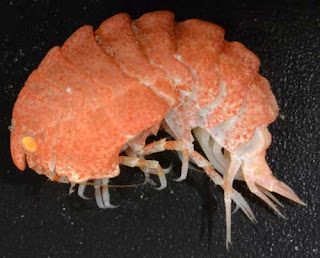11.02.2013 (Monday). I wake up at
02:10 in the morning. I quickly eat a sandwich and go down. There, Freija
Haucquier told me that there were problems with the Multicorer (the gear for
sampling carots of sediment), which has to be replicated. So I woke up much too
early. I knock to the door of the room of Marie and told her that she may sleep
a little bit more. When the dredge comes up it is full of mud; only one
amphipod. The Agassiz trawl has a distinctive
fragrance of H2S and is full of black fluid mud. Yet, there are a
lot of irregular sea urchins, gastropods, Notocrangons, and some fishes.
Afterwards I go sleeping until 17:00. At 18:00, we have an extraordinary view
on Andersson Island aka Rosamel Island. An unbelievable hood of clouds
anchors at the top of this small volcanic island with huge cliffs all around.
Then new Agassiz trawl and dredge. The OFOS video camera views indicate that
we could expect a great catch. There is indeed a lot of organisms in the net.
Almost no mud this time! A lot of ascidians (especially Molgula sp.) and huge red ophiurids. More than twenty giant Glyptonotus, including a male grasping
its female. Several species of amphipods. We sort the sample of the trawl until
middnight or a little later.
(Cédric)
The dredge was delayed and took place around 4 am. That gave me a little more time to recover. It wasn’t for much, finally, we just catched one common amphipod in the dredge and that’s it. This wasn’t a good sign for the Agassiz trawl, we were not very optimistic about the richness of this sampling site and what we could catch. Indeed, at first sight it looks quite lifeless. When we wash the mud, we can however find a good amount of sea urchins, decapods, but no amphipods. Disappointing sampling this morning, but it’ll give us the occasion to sleep before the last one. I sleep all the afternoon and wake up around 17h30. The Agassiz takes place in the evening, followed by a dredge. The catch is great this time. Almost no mud and a whole bunch of all kinds of organisms. Among the most impressive ones were those giant isopods that look like huge cockroaches, the Glyptonotus. We found tens of them, some about 15 cm long. Again 2 huge starfishes, one even bigger than the last one. And a lot of amphipods, however many belonging to the same species : Waldeckia obesa, Epimeria georgiana and Iphimediella rigida. This catch keeps us working late again, around 4 am, but we’re happy we had a last good catch because the next days will be quiet again. There will be one last small week of krill survey before we start again with benthos sampling.
(Marie)
(Cédric)
The dredge was delayed and took place around 4 am. That gave me a little more time to recover. It wasn’t for much, finally, we just catched one common amphipod in the dredge and that’s it. This wasn’t a good sign for the Agassiz trawl, we were not very optimistic about the richness of this sampling site and what we could catch. Indeed, at first sight it looks quite lifeless. When we wash the mud, we can however find a good amount of sea urchins, decapods, but no amphipods. Disappointing sampling this morning, but it’ll give us the occasion to sleep before the last one. I sleep all the afternoon and wake up around 17h30. The Agassiz takes place in the evening, followed by a dredge. The catch is great this time. Almost no mud and a whole bunch of all kinds of organisms. Among the most impressive ones were those giant isopods that look like huge cockroaches, the Glyptonotus. We found tens of them, some about 15 cm long. Again 2 huge starfishes, one even bigger than the last one. And a lot of amphipods, however many belonging to the same species : Waldeckia obesa, Epimeria georgiana and Iphimediella rigida. This catch keeps us working late again, around 4 am, but we’re happy we had a last good catch because the next days will be quiet again. There will be one last small week of krill survey before we start again with benthos sampling.
(Marie)
Andersson Island aka Rosamel Island.
Catch of the Agassiz trawl.
Marie looking for amphipods.
Cleaning the scientists after work with muddy samples.
Male Glyptonotus grasping his female.
Glyptonotus are giant isopods.
Arcturid isopod (50 mm without the antennae).
Giant red ophiurids (leg span about 350 mm).
(Pictures by Cédric)















































